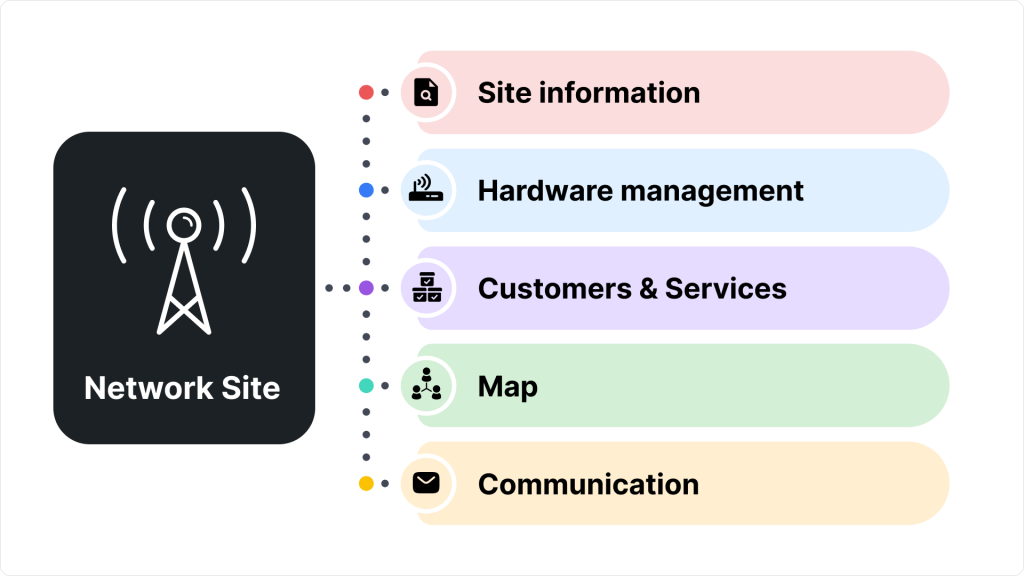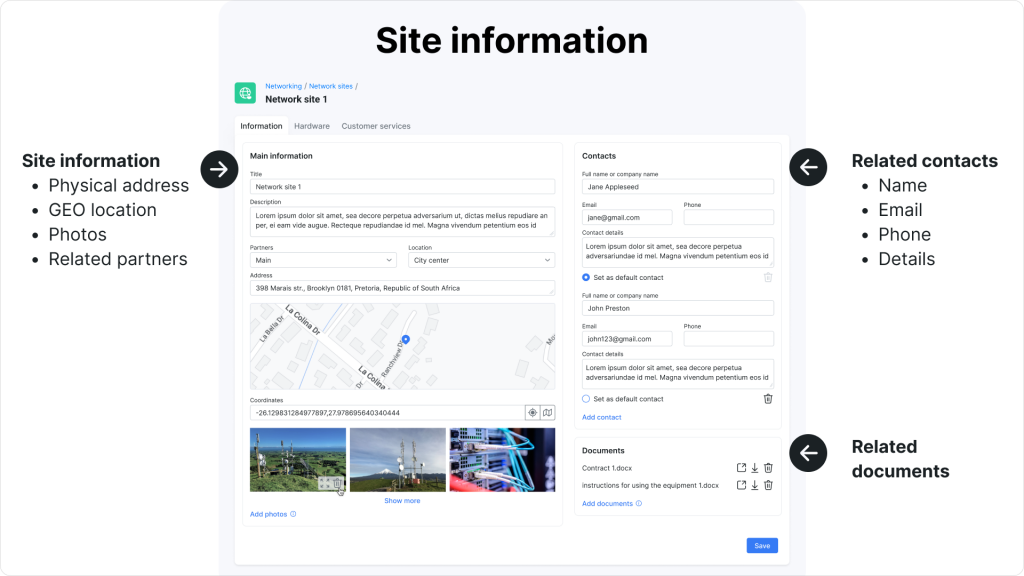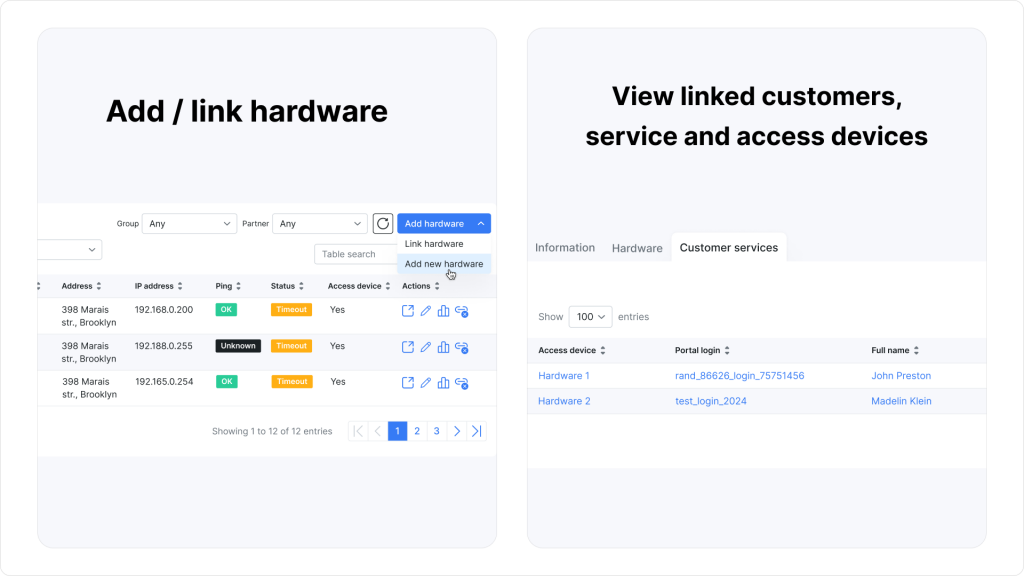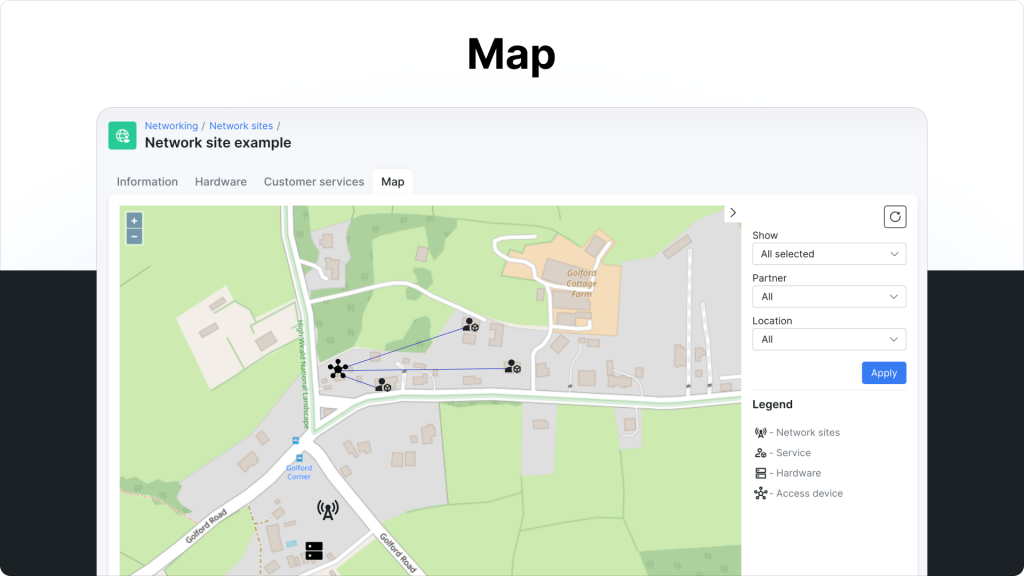



Local WISPs can outcompete the big ISPs in terms of service quality — there’s a sizeable portion of less tech-savvy customers who really appreciate the service aspect. At the same time, ISPs seek to optimize network management, reducing HR and operational costs. So, how can this be done with maximum benefit for the internet provider but without sacrificing the service for the consumer? What should you pay attention to? How can you correct shortcomings and make network management more effective? We have some tips.
The newest Splynx (v5.0) offers major updates to enhance your WISP operations, just in the part of network management. The most prominent ones are the new Network sites for more efficient administration and monitoring of your network to keep things running smoothly. This new module further extends Splynx’s network management functionality by organizing installed equipment (routers, antennas, access devices), clients, and services associated with specific network locations like towers or points of presence (PoPs) — all in one place. Hence, they’re always just a click away. And you also get more streamlined client communication and efficient tracking for all your network staff.

In fact, the lack of central IP address management, equipment tracking, and network mapping are among the most common challenges ISPs/VISPs/WISPs face. One of our current clients (Skywire) has reduced time for customer provision up to three times compared to before the Splynx deployment. Speaking about this, recently, we interviewed over 50 ISPs — also Splynx customers — and compiled their insights into a detailed guide on the top 10 challenges local ISPs face and how Splynx can help overcome them. You can read it here.
Splynx Network Sites features are under the Networking section alongside existing Routers for RADIUS authentication, TR-069 (ACS) and Hardware. This entirely new entity (a kind of central hub) gives you and your support agents new levels of customization and flexibility to manage everything within your network infrastructure naturally, without juggling between settings scattered in different places.
Now let’s look closer at the Network sites page layout and feature main possibilities. Here’s a quick overview of the main elements and what they are for:



Mass messaging for better communication and customer service SMS/email sending
In case of network issues (maintenance or outages) related to the network site, it’s often necessary to notify specific customers quickly. The new ability to send mass emails and SMS messages to customers connected to the same network site simplifies this. You can now send targeted notifications to customers connected to a specific site or access device groups. This helps prevent support tickets related to outages, such as “Internet not working,” saving you time while improving communication.
More customization and flexibility than ever
Specific Network sites can be filtered by partner and location, making it easier to find specific sites or groups of sites so that you can manage large networks more efficiently. At the same time, Network sites list can be exported for further reporting and analysis; plus a few table view customizable options to show preferred fields or columns, making it easier to focus on specific data that matter at this point.
Linking customer services to specific Network sites makes it easier to manage resources, maintain equipment, improve service delivery and communicate with clients. Thanks to consolidating all site-related data into one central hub within Network sites, one of the most common problems has fallen away — no more switching between multiple screens. Now, everything can be accessed in one place. For instance, you can create a site, assign contacts, upload important documents (like rental contracts), and track the hardware and services associated with that site.
Imagine this situation: access devices in one of your critical locations suddenly goes down, causing a temporary service disruption. Without a proper system in place, you’d have to dig through numerous records, manually find out which customers are connected to this device, and inform them one by one. It’s inefficient, time-consuming, and prone to error. Worse, if you miss notifying a customer, they might reach out angrily, frustrated that their service was interrupted without warning.
With Network sites, you’re now fully in control, ensuring every customer gets the right message at the right time. This is a must-have tool, and the difference it makes in customer communication and network management is immense. No painstaking manual processes (cross-referencing lists) or workarounds (creating various additional fields to filter customers) — it’s all handled within a few clicks. You can draft a mass message (or use one of the templates) for the target group, letting them know about the upcoming maintenance and what to expect.
In a matter of minutes, you’ve notified every customer who might be impacted, reducing the number of support calls and complaints. So, you can save time and build trust with your customers. They appreciate the proactive communication, knowing they’re informed and that you’re on top of your network’s operations.
Important to note: Network sites feature is in the first phase of development. This is the first version, and now we are gathering feedback from customers to improve it for their needs. Actually, we’ve already received several favorable, meaningful ideas. For example, clients who started to use it, saying that their customers are connected to access points in the dynamic mode. They will really like to have it not in the static way, but in the kind of dynamic way, using SNMP or Neighbor Discovery Protocol. It’s a great idea, and we will think about how can implement it in future releases.
We appreciate any feedback. So, if you think that something is not designed correctly and should be improved or have any other suggestions, please feel free because it’s a new, completely new feature, a new entity in Splynx. Just a friendly reminder about the special Splynx Feedback page where you can post ideas on future features or improvements, vote on suggestions from other community members, and stay in the loop with our live roadmap and changelog.
With Network sites we’re laying the foundation for even more advanced network management capabilities. That is the first main pillar for future improvements, as our focus for next releases and for next year will be more working with networking equipment and improving specifically networking part of Splynx. Like topology, mapping and BDC reports for American market. So that’s why Network sites is quite a big development and important part for future development of Splynx.
You can add an unlimited number of Network sites for easier, structured management approach; each with linked hardware devices, access devices, customers and services. For more information on how to change the network site details, link and configure everything, check out our official documentation.
Find out how Splynx helps ISPs grow
Learn more